The Best Things to Do in Olympic National Park
Olympic National Park is one of the most diverse national parks in the country. Within its sprawling boundaries, you’ll find a cornucopia of activities – from beaches, to snow capped peaks, to temperate rainforests – that will have your jaw on the floor, marveling at the sheer amount of natural beauty packed into the park.
Over the past few years, we’ve visited Olympic National park multiple times, including a couple of backpacking trips to experience the park’s backcountry. Each time, we’ve walked away impressed at the diversity of the park.
Rather than seeing one type of landscape within the boundaries of the park, which is usually the case with national parks (see: Mount Rainier, Arches, etc etc), you get at least three different ecosystems within Olympic’s boundaries: coastal, alpine, and temperate rainforest.
In this guide, we’re going to cover the best things to do in Olympic National Park, at least in our minds. We’ll cover everything in the park from romps on rugged Pacific beaches, to jaw-dropping vistas on backcountry adventures, and everything in between.
We’ll do our best to not only inspire you and add some ideas for things to do and see for your own trip, but give you some practical details you should know to make your trip a smooth one.
Sound good to you? Let’s get into it.
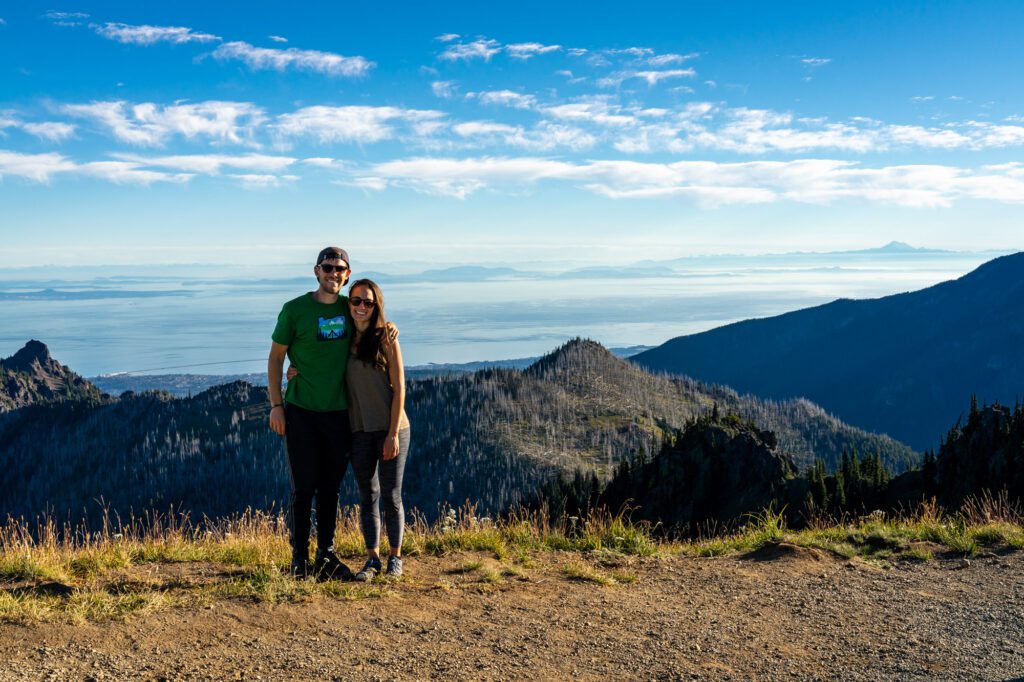
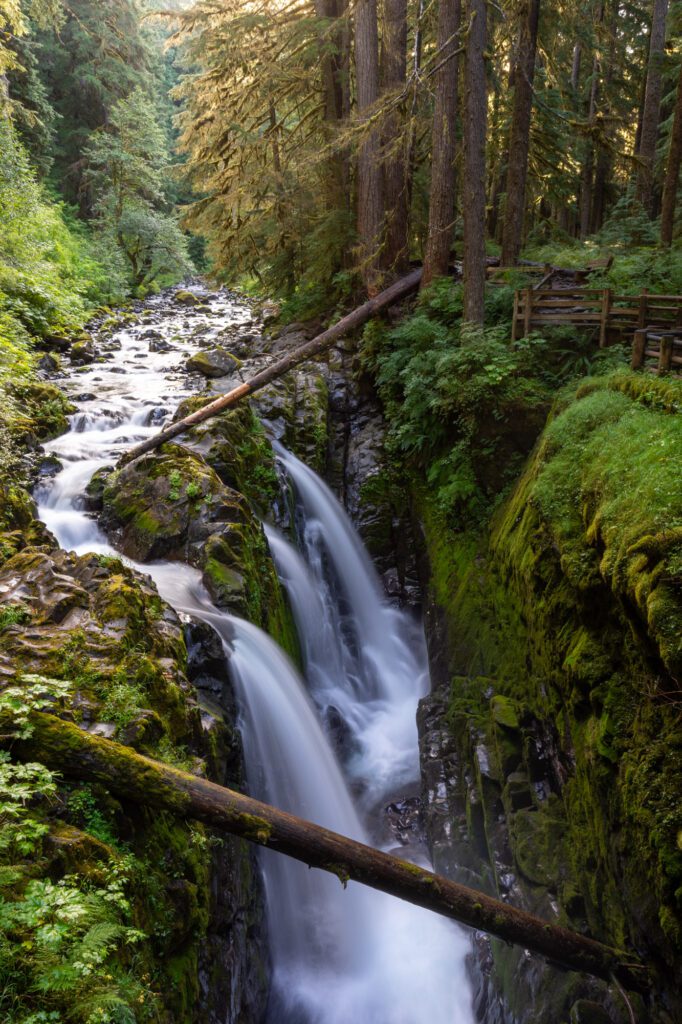
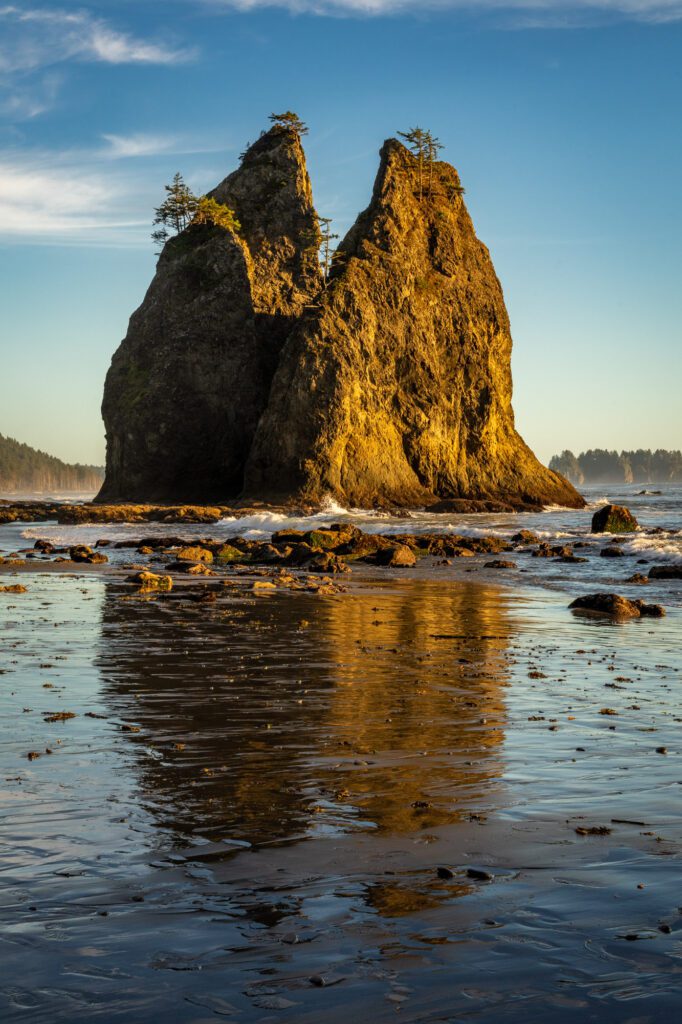
Disclaimer: Some of the links in this post, like hotel links, are affiliate links, meaning at no additional cost to you, we make a little bit of money if you click through and book. That being said, we would never recommend something to you that we don’t stand behind 100%.
The Best Things to Do in Olympic National Park: A Complete Guide
And now on to the main event!
Given the park’s fragmented geography, we think the best way to organize this guide is by region.
We like to break the park up into five distinct regions: Hurricane Ridge, Lake Crescent and the Sol Duc Valley, the Central Pacific Coast, the Rainforests, and the Northern Pacific Coast.
There are obviously other ways to break it up, but that’s the way that makes the most sense to us (and is how we’ve thought about it on our various trips to Olympic), so that’s what we’re going with!
Below, you’ll find our take on what to do and see in Olympic National Park, broken out by region, to help you plan an unforgettable trip.
Hurricane Ridge
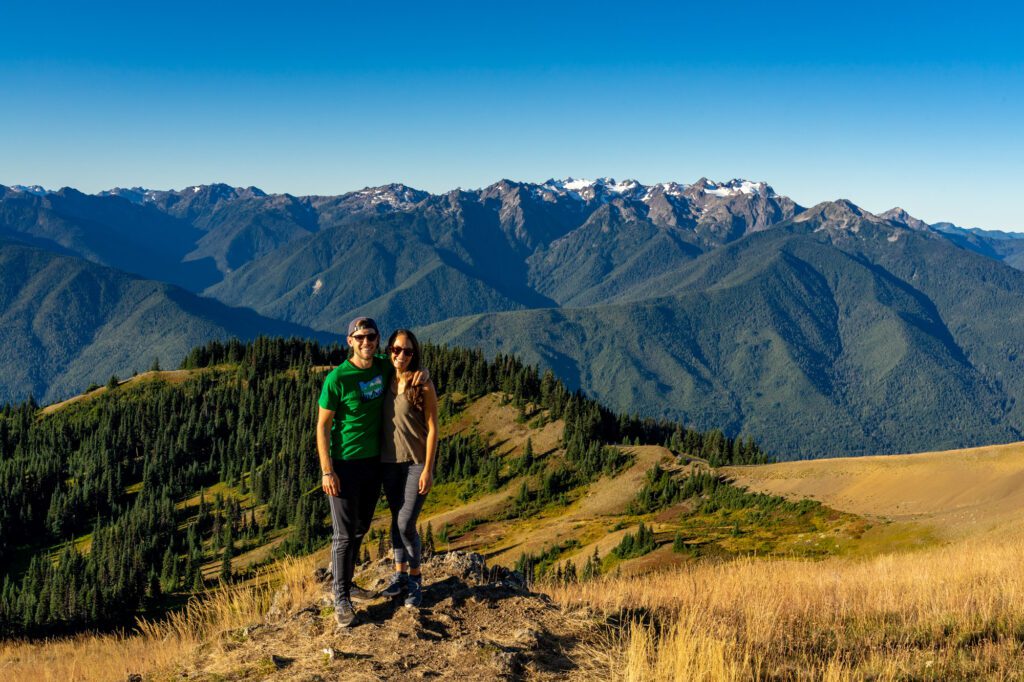
Hurricane Ridge is the highest elevation in the park you can drive to, and is home to some truly spectacular views of the surrounding landscapes along with some of the best hikes in Olympic National Park.
Keep in mind as you’re planning your time that it takes 30-45 minutes to get up to Hurricane Ridge from the lower elevation area in Port Angeles along a narrow two lane road that may or may not have insane traffic.
We’d highly recommend making this the first stop of the day, and planning on getting there before 9:00 am if you can swing it (which is why we recommend staying in either Port Angeles or around Lake Sutherland in our guide to the best places to stay in Olympic National Park).
Hike to Panoramic Views from the Top of Hurricane Hill
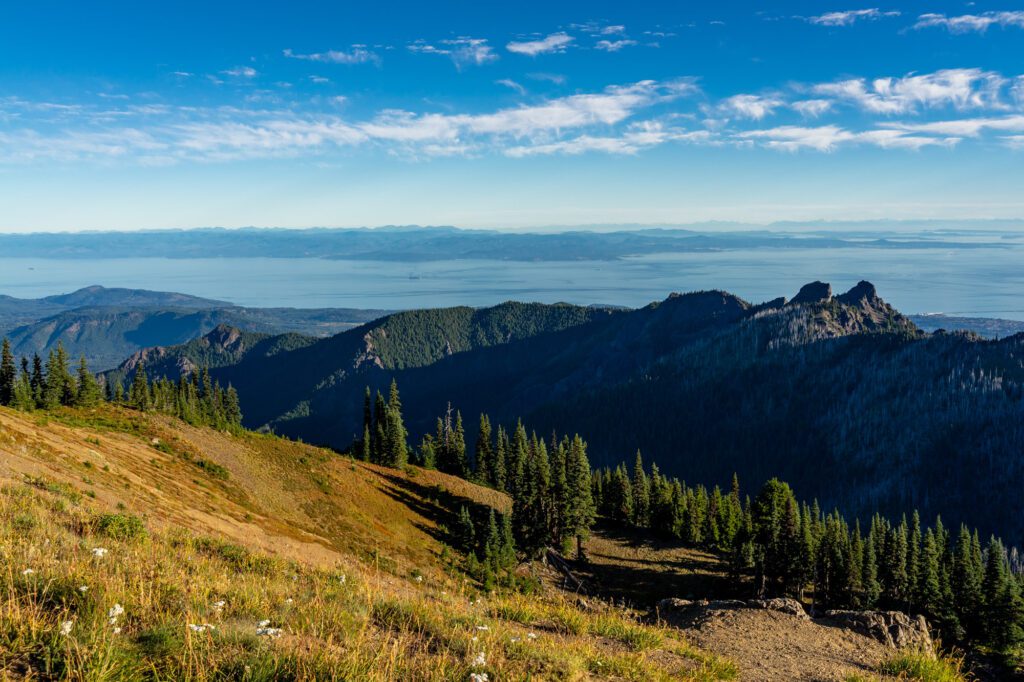
When we did the short hike up to Hurricane Hill early one summer morning when we were living in our minivan, the conditions were nearly perfect.
It was a sunny clear morning, we saw a cute little black bear on the way to the trailhead, and we saw exactly two other people on the trail.
From the top of this hike, which is paved most of the way up but does some climbing, you can see nearly the entire northwest corner of Washington and across the Strait of Juan de Fuca over to Victoria, B.C. (that’s Canada, folks!) and Vancouver Island.
To the east is Mount Baker, and to the south are the snowy peaks of the Olympic Range, including Mount Olympus.
It’s one of our favorite easy hikes in Washington State, and it’s our favorite thing to do up at Hurricane Ridge.
Drive Out On Obstruction Point Road for Some of the Best Views of the Olympic Mountains
Obstruction Point Road is not for the faint of heart (or for RV’s). It’s a narrow, gravel road that often has a steep drop off on either side (sometimes both) that is only open during the summer time.
But if you’re looking for some of the park’s best views of the Olympic Mountains, some of the park’s clearest alpine lakes, and a cornucopia of wildflowers in the early summer, this is the place to be!
And, let’s be honest, who is reading this guide and is NOT looking for those things?
Anyway, by the end of that seven mile drive out to the Obstruction Point Trailhead, you’ll be ready to get out and stretch your legs.
There are a few hikes that leave from there – including Elk Mountain and Grand Lake – but it’s worth coming out here even if you’re not up for a long hike.
Make sure to check road conditions here before your trip to confirm that it’s open before you head out there.
Lake Crescent and the Sol Duc Valley
Lake Crescent is about 20 minutes west of Port Angeles, the biggest city that borders the park, and we consider it the signal that you’ve reached the edge of the park.
The Sol Duc Valley is the area around Sol Duc Road, which turns south off of Highway 101 and meanders its way up through dense evergreen forests to the Sol Duc Trailhead.
Combined, these two areas offer a plethora of different activities, including a couple of great easy hikes to some of the best waterfalls in Washington, a nice midrange hike, and an epic backcountry adventure that is one of our favorite backpacking trips of all time.
Explore the Shore of Lake Crescent
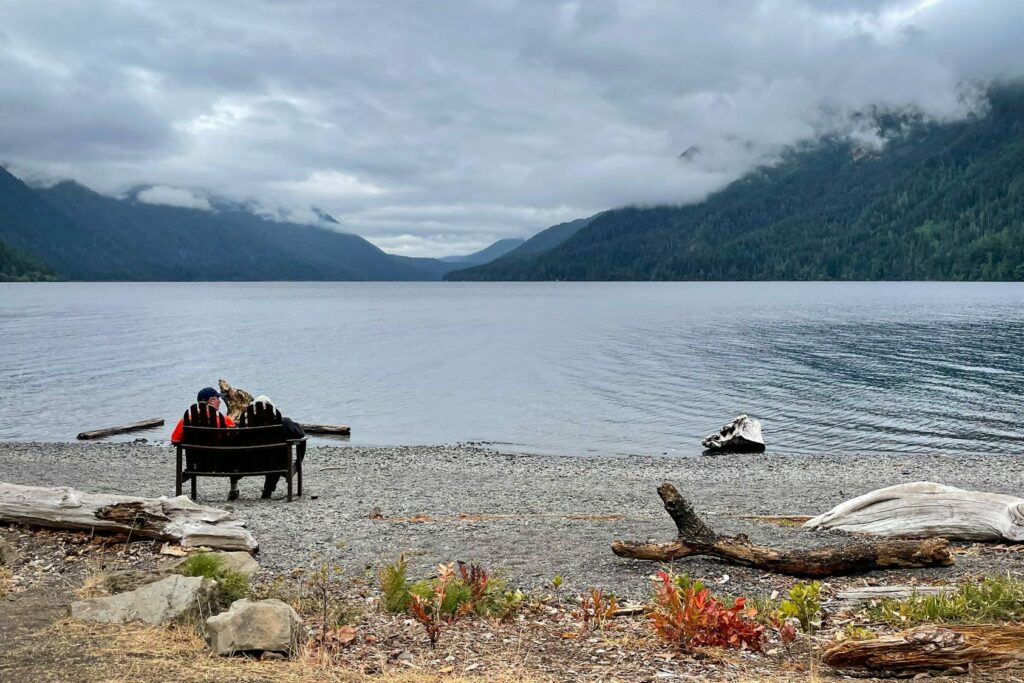
Like we mentioned above, we consider Lake Crescent to be the signal that you’re entering the wilderness in Olympic National Park as you’re driving west from Port Angeles.
You’ll first pass by Lake Sutherland (which is a good place to stay because there are a bunch of cabins along the lakeshore), which we recently learned was connected to Lake Crescent until a huge landslide separated them about seven millenia ago. You know, recent history.
In addition to being home to a couple of worthwhile hikes (we’ll get there in a second), Lake Crescent is a great destination in its own right.
It’s the second deepest lake in Washington (can you guess the first?) and you can rent various watercraft at the Lake Crescent Lodge on the lake’s south shore.
The Lake Crescent Lodge is also worth a visit, possibly for a post-hike lakefront drink?
It’s a beautiful building that was built in the early 20th Century and has that rustic charm that only a national park lodge can have, but we probably wouldn’t stay there.
The other thing to do if you have some extra time is to head out to the northern shore of the lake and hike or bike a portion of the Spruce Railroad Trail, which follows the old railroad route.
It’s about ten miles total, one way, so you’re probably not hiking the entire thing. It is paved the entire way, which makes it a nice bike ride.
Marvel at Marymere Falls
Marymere Falls is a nice and easy hike – 2 miles and 500 feet of elevation gain – from the Lake Crescent Lodge, and is family-friendly. We saw tons of families with kids making their way up to the falls.
You’ll cross under Highway 101 and enter a dense, ferny forest, passing the turnoff to Mount Storm King (which we’ll cover next) before you reach Barnes Creek, cross a wooden bridge, and head up to Marymere Falls.
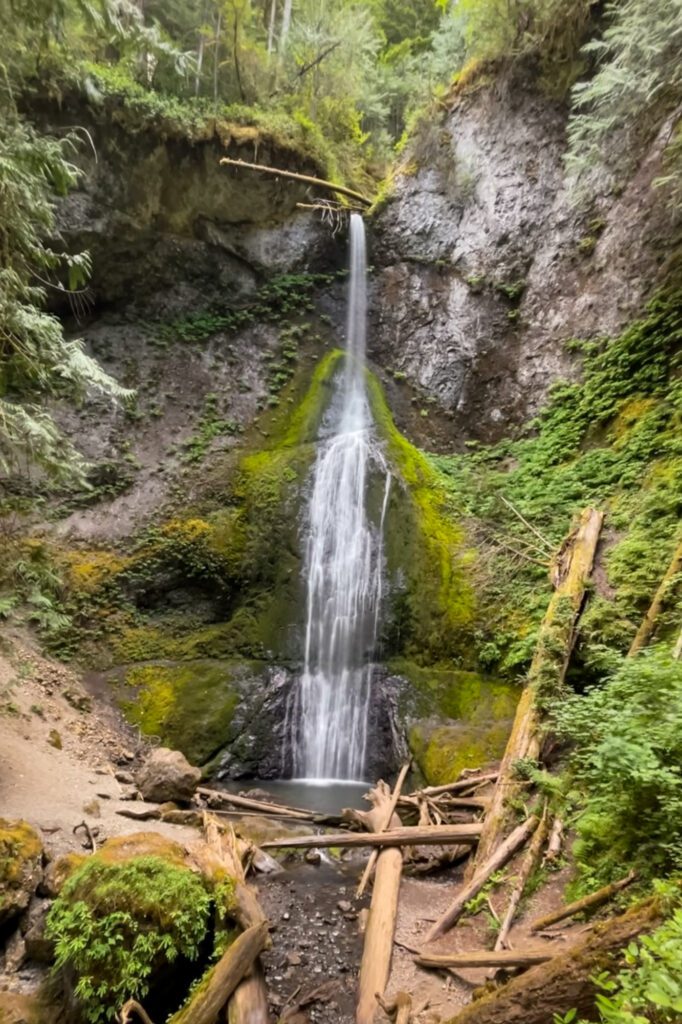
The falls itself plunges 90 feet off of a ledge high above the viewing platform, and is surrounded by all sorts of bright green mosses as it falls into a small pool below.
It’s worth the low effort to get there, and is a good add on to the hike up to Storm King if you have the time.
Hike to the Top of Mount Storm King
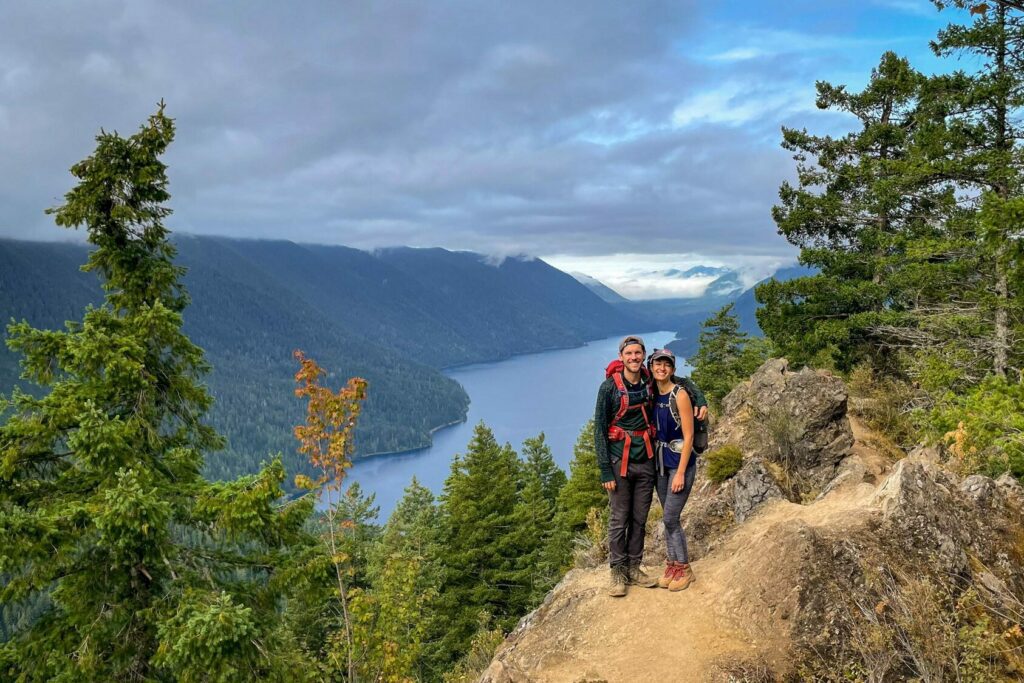
We have mixed feelings about Mount Storm King. On the one hand, it’s certainly a nice view. On the other hand, it’s kind of all about the view (the rest of the hike is a fairly boring, steep ascent), and the effort to make it up there isn’t really worth it in our humble opinions.
We’d suggest saving your energy to tackle a hike up on Hurricane Ridge, if you have to choose.
For your reference, it’s a 4 mile hike (roundtrip) with 2,050 feet of elevation gained.
From the top of Mount Storm King, you have a nice view out over Lake Crescent to the north, but that’s about it.
No panoramic vistas of the Olympic Mountains. No coastal views. The lake is beautiful, sure, but we think you can do better in this beautiful, diverse park.
The other thing to know is that there is a section right before the top that includes a rope-assisted scramble.
Not for the faint of heart, especially when it’s wet (which is a lot of the time in this part of the world).
Meander Through the Forest to Sol Duc Falls
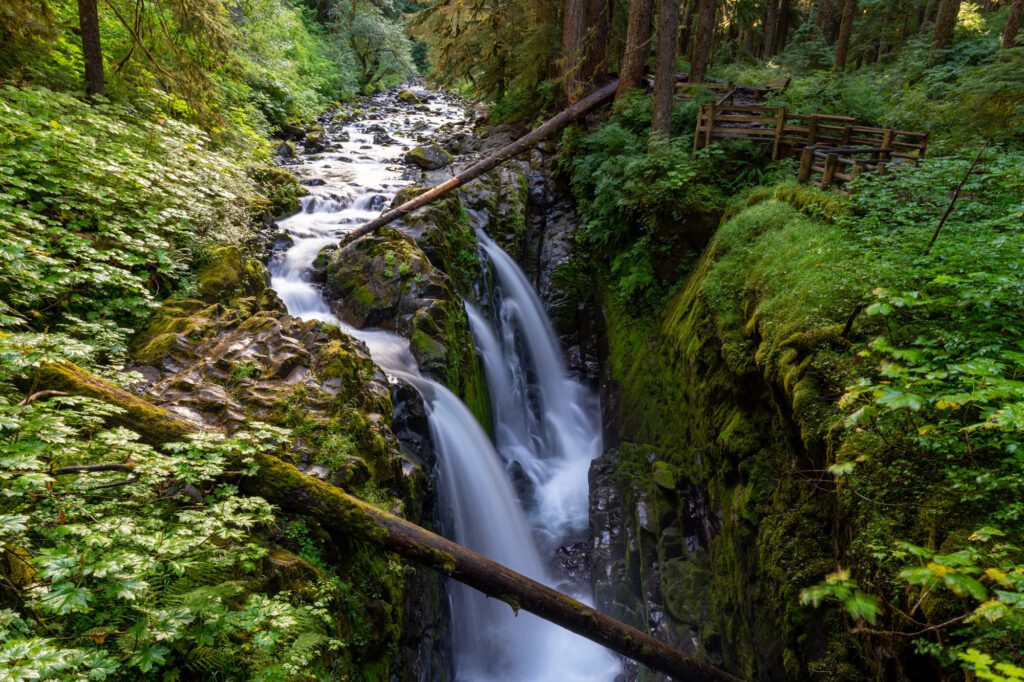
We love this short hike – 1.5 miles roundtrip and minimal elevation gain – and the waterfall that’s at the end of it.
We’ve never actually done this hike as a standalone hike, only as part of the High Divide Trail (more on that excellent hike in a second).
Sol Duc Falls is unique because you view it from the middle of a wooden bridge over the Sol Duc River, with the falls dumping into a canyon below you and flowing downhill behind you.
It’s a bit of a journey to get out to the trailhead from Highway 101, but the falls are nice, the stroll through the dense forest gives you a taste of the miles and miles of untouched forest that covers the Olympic Peninsula, and it’s about as easy as a hike as you could ask for.
Experience the Magical High Divide Trail (Backcountry Camping)
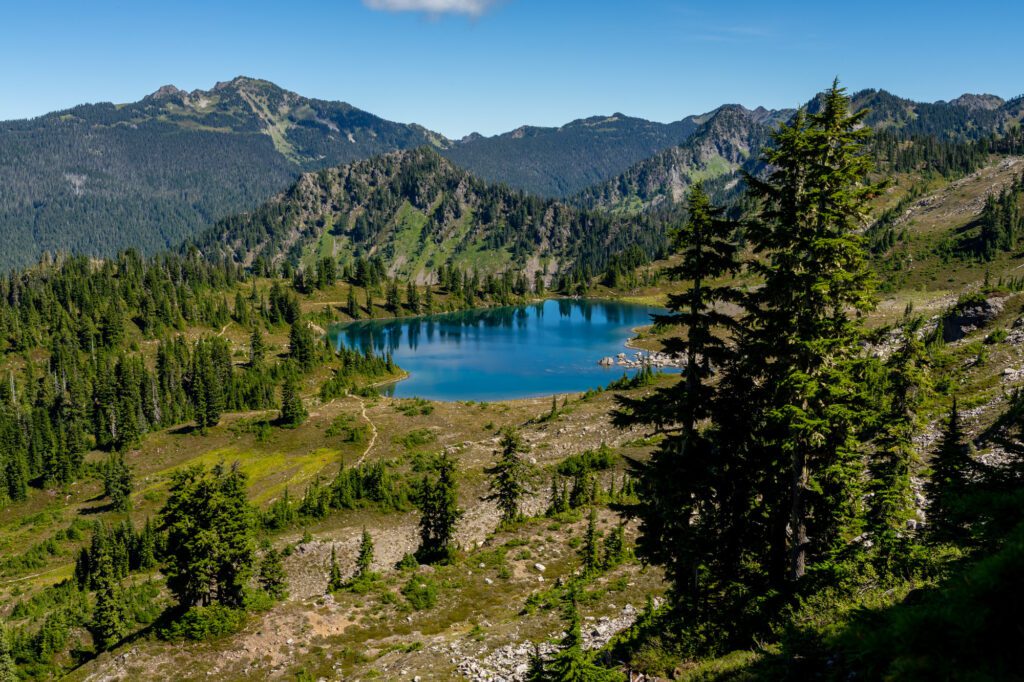
The High Divide Trail is one of the few backpacking trails that we’ve done where we got to the end and said “yeah, we’d do that again.”
For example, after hiking the Enchantments a few years ago, we were pretty sure we wouldn’t do it again in our lifetime.
Now, that doesn’t mean this hike is an easy one – it’s a 19 mile loop with 4,000 feet of elevation gain, including a stretch along a narrow rocky ridge (the High Divide) – but the time spent in the Seven Lakes Basin is worth the price of admission.
It’s not called the Seven Lakes Basin for nothing – along the way, you’ll pass numerous different alpine lakes that are various shades of blue.
Our favorites were Heart Lake – which is on the east end of the High Divide – and Lunch Lake, which is up on the High Divide (and is a campsite that you should definitely try to spend a night at, if you can swing it).
Here are some other pictures for your viewing pleasure.
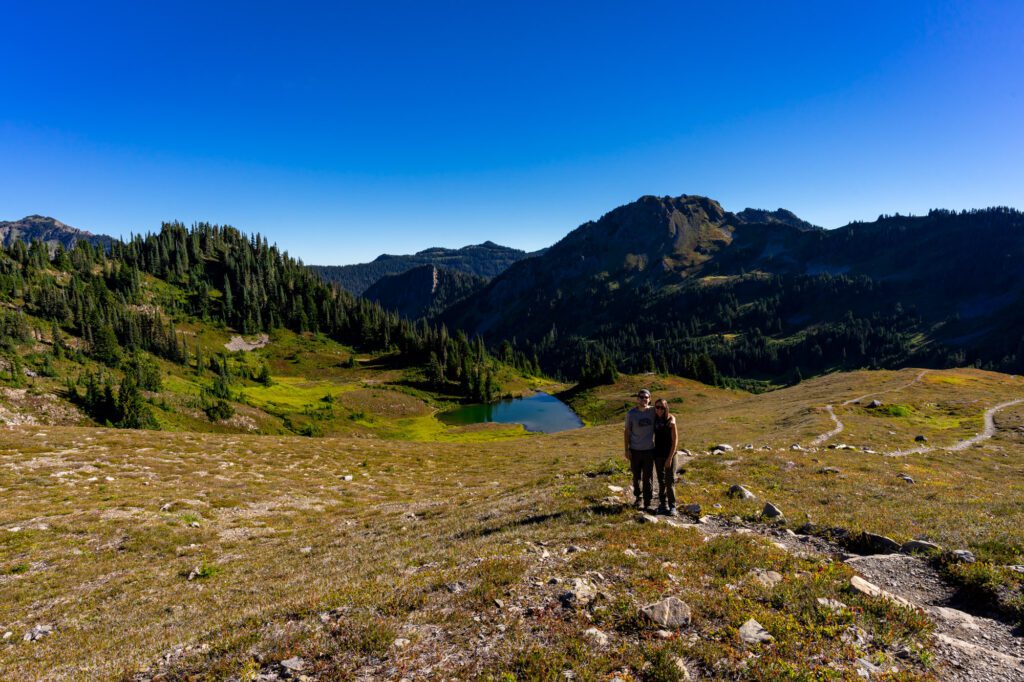
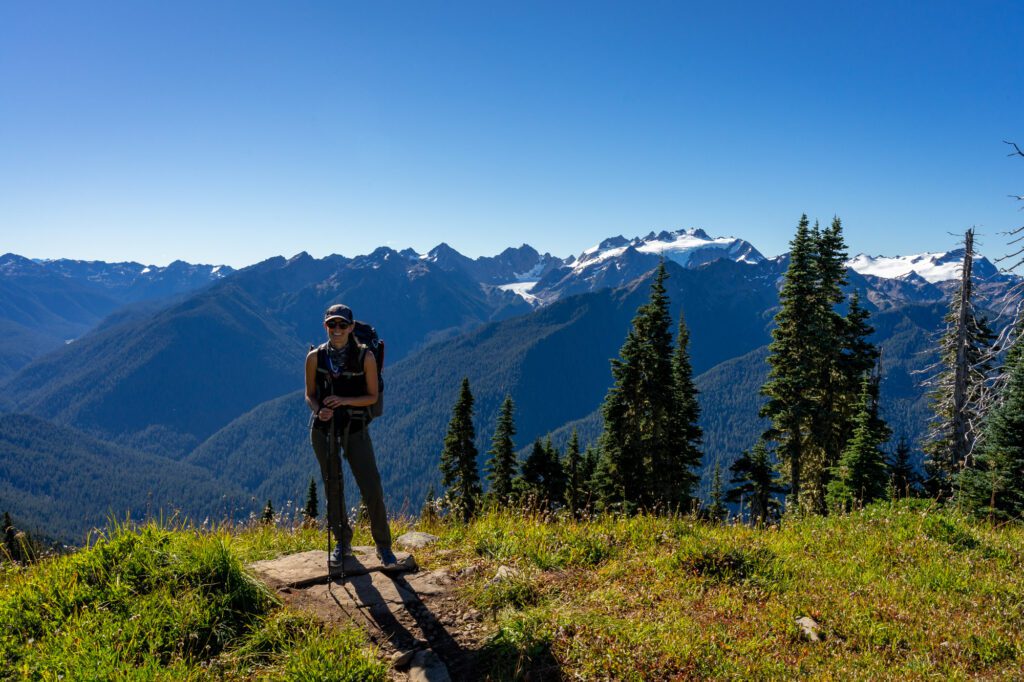
We have an entire separate guide dedicated to hiking the High Divide Trail (COMING SOON) that you should read if you’re remotely interested in this incredible backcountry adventure.
At the very least, you’ll need backcountry camping reservations and a backcountry permit (which you can get here), along with a bear canister.
The Central Pacific Coast
We’re calling this the Central Pacific Coast, but it’s really the entire Pacific Coastline from the Kalaloch Beaches at the southern end of the park, up to Rialto Beach just outside of Forks.
It’s the most easily accessible stretch of coast in the park (we’ll talk about the more remote Northern Pacific Coast in a second), and is full of amazing sandy beaches to experience.
Walk Along Rialto Beach Out to Hole-in-the-Wall
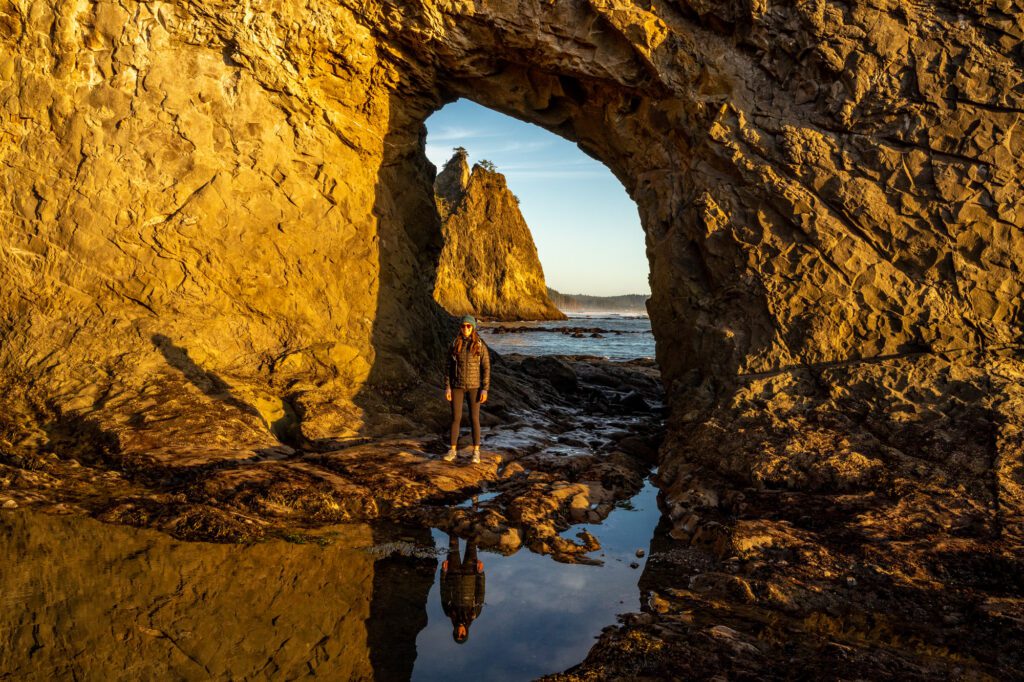
This is another must-do activity in Olympic National Park in our opinion. We did it at sunset on our first ever visit to Olympic National Park, and it was one of the highlights of our entire year.
This 3 mile hike out and back to Hole in the Wall, which is exactly what it sounds like, is an excellent late afternoon / early evening activity when the sun washes over the beach in a soft golden glow.
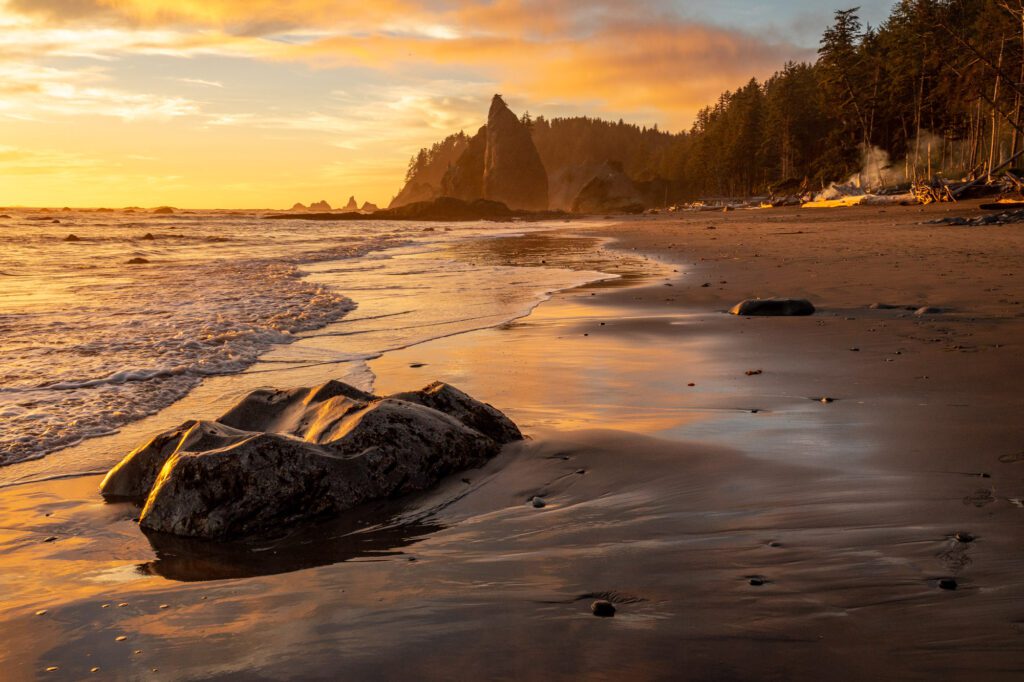
It’s not a tough hike in terms of elevation – it’s actually flat the entire way there and back – but you will be walking in sand, which means high top boots are going to be helpful to keep sand out of your shoes.
And hiking in sand is always approximately 1.5 times harder than any other surface, in our experience.
Keep an eye out for bald eagles in the trees up above the beach – we’ve seen many eagles perched up there waiting for their next meal.
Head Out to the Three La Push Beaches (But Second Beach is the Best)
La Push is on the coast west of the former timber town of Forks, now best known as the setting for the Twilight movies, and is home to three great beaches.
They are, creatively, named First, Second, and Third Beach.
This area is home to the Quileute Nation. They manage this stretch of the coast, and you need to respect the posted rules and regulations (for example, you cannot remove shells, driftwood, or any other natural element from the beaches).
Learn more about the history of this land and the Quileute Nation here.
Each of the three beaches requires a short hike to reach (except First Beach, which is at the parking area). Here are the details:
First Beach: No hike required
Second Beach: 0.6 miles down to the beach (one way)
Third Beach: 1.2 miles to the beach (one way), 2.5 miles to Taylor Point (a nice viewpoint).
Admire the Sea Stacks and Driftwood at Ruby Beach
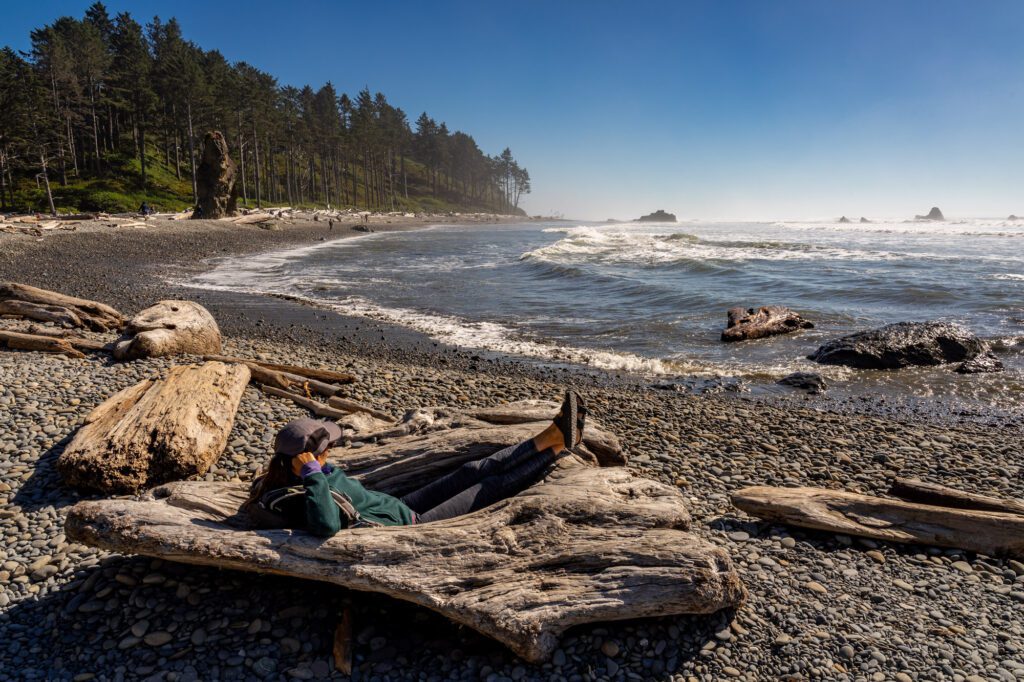
Ruby Beach is one of our favorite beaches in Olympic National Park, though judging by the crowds, a lot of people seem to agree with us. It has two of the trademark aspects of beaches on the Pacific Coast in Washington State: driftwood and sea stacks.
The parking lot gets packed here, and this is a good spot to do early in the morning or late in the afternoon in an effort to avoid those crowds.
Part of the reason is the fact that it’s a very short walk from the parking lot, which means that the barrier to entry is nearly nonexistent.
We’re definitely not saying don’t go, we’re saying be aware that you’re not going to have a whole lot of solitude when you do.
See the Tree of Life at Kalaloch
The beach around the Kalaloch Lodge at the south end of this part of the coast is technically split up into a few different sections, but it’s one of the longest stretches of sandy beach in the park.
Just below the campground at Kalaloch there’s a specific tree that is perched up on a bluff that, over the course of the years, has eroded, leaving the roots exposed. It’s known as the Tree of Life, and it’s worth a quick stop and walk along the beach.
Camp on the Beach
One of the unique things about Olympic National Park is that you can spend a night camping on the beach relatively easily. Unlike places like the Lost Coast Trail in northern California, you can camp on the beach with limited hiking to reach the beach.
In some cases, you can just park at the parking lot for the beach, and you’re basically there (though that’s the least fun option, we think).
One thing to keep in mind here is that it rains A LOT in Olympic National Park.
We had permits to camp on the beach last August, but decided to bail when we showed up and it was pouring sideways, which wouldn’t have been much fun at all.
For some good beach camping that is significantly less crowded, hike south past Third Beach and continue along the South Coast Route, which runs south all the way to the mouth of the Hoh River (just north of Ruby Beach).
There are countless campsites along the coast, and permits are generally easier to get because you have to go further than, say, Rialto.
Wilderness permits are required to camp on the beach, and you need to have a bear canister.
Some of the most popular places to camp are Rialto Beach (at the end of the beach towards Hole-in-the-Wall, where camping is allowed), Shi Shi Beach, and out near Lake Ozette.
The Rainforests
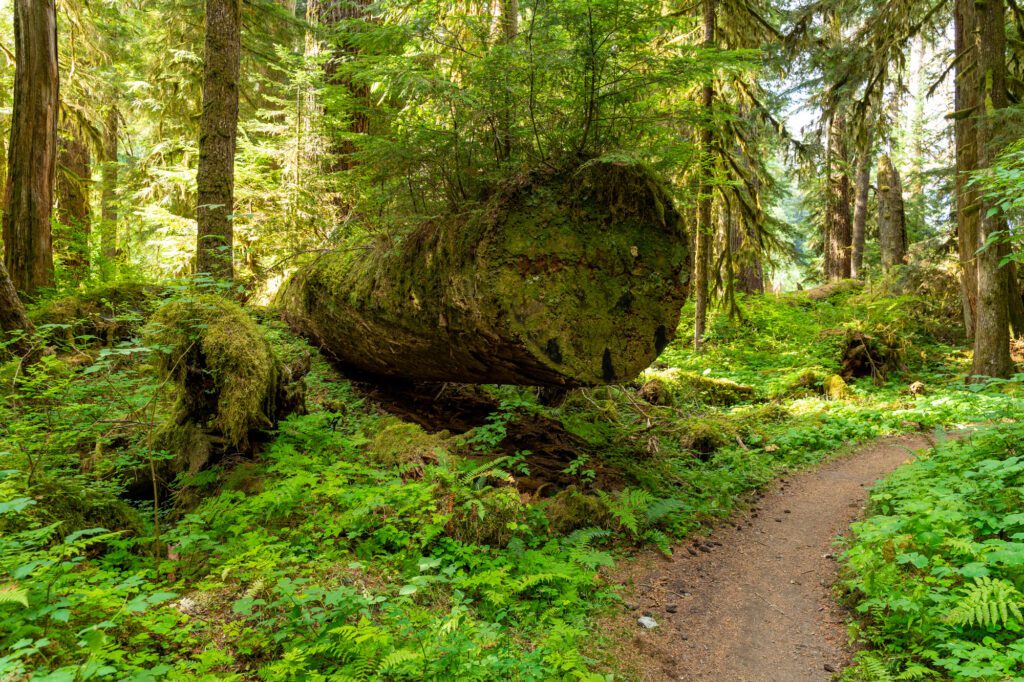
The amount of rain that this part of the world gets every year means that it’s a lush, green, wonderfully wet example of the coastal temperate rainforest.
This unique ecological feature is a staple of the Pacific Northwest coast, and the Hoh Rainforest in particular is one of the best examples in the world.
One thing to note about the Hoh Rainforest: The parking lot is tiny relative to the amount of people who want to see it. That means that, on summer mornings, they limit access to the parking area and stop people at the ranger station once the lot is full.
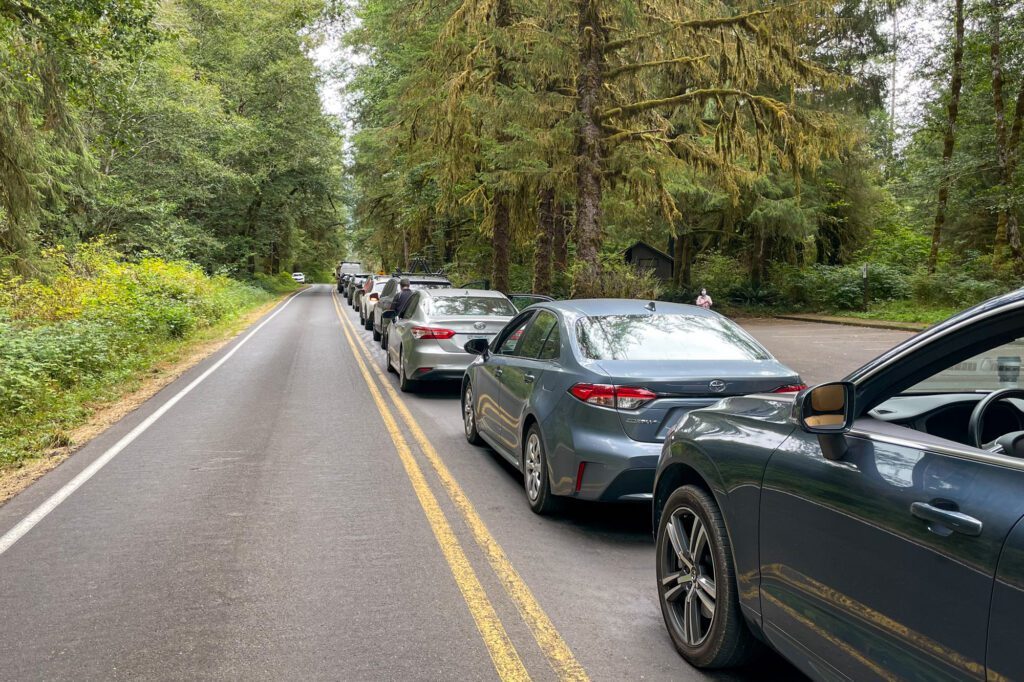
From then on, it’s one in, one out. We ended up stuck in a line of cars for over an hour because we took our sweet time, so take our advice and get out to the Hoh Rainforest by 9:00 am or so to avoid it.
Plus, the rainforest is much more peaceful when it’s not crawling with humans.
Walk Through the Hall of Mosses and Spruce Nature Trail
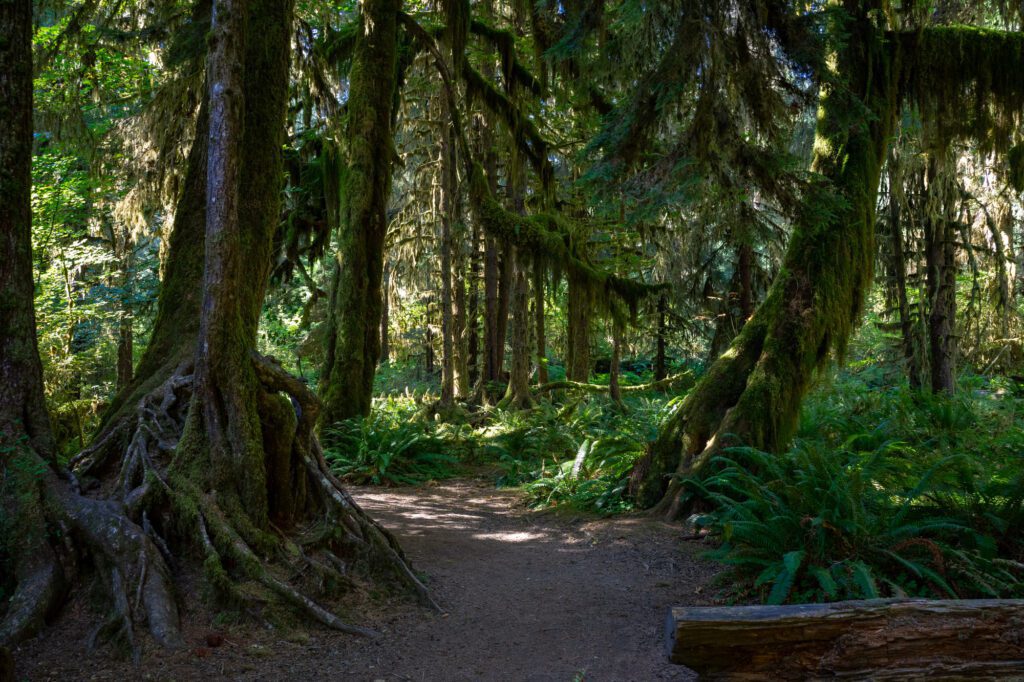
The Hoh Rainforest is, perhaps, the most popular area in the entire park.
Now, it’s not a rainforest in the tropical sense, like you might find in the Amazon. That’s hardly “temperate.”
Instead, as you enter the rainforest, you’ll find a diverse ecosystem full of every shade of green that exists in the world, from bright green ferns covering the forest floor, to deep green mosses and evergreen trees.
Plus a cornucopia of wildlife, namely the elusive Roosevelt Elk who sometimes make an appearance here.
Once you navigate the parking situation, there are a couple of short trails to tackle that serve as a great introduction to the rainforest – the Hall of Mosses and the Spruce Nature Trail.
Both are worth doing, and are accessible for hikers of all ages and experience levels.
Hike Deeper into the Rainforest on a Portion of the Hoh River Trail
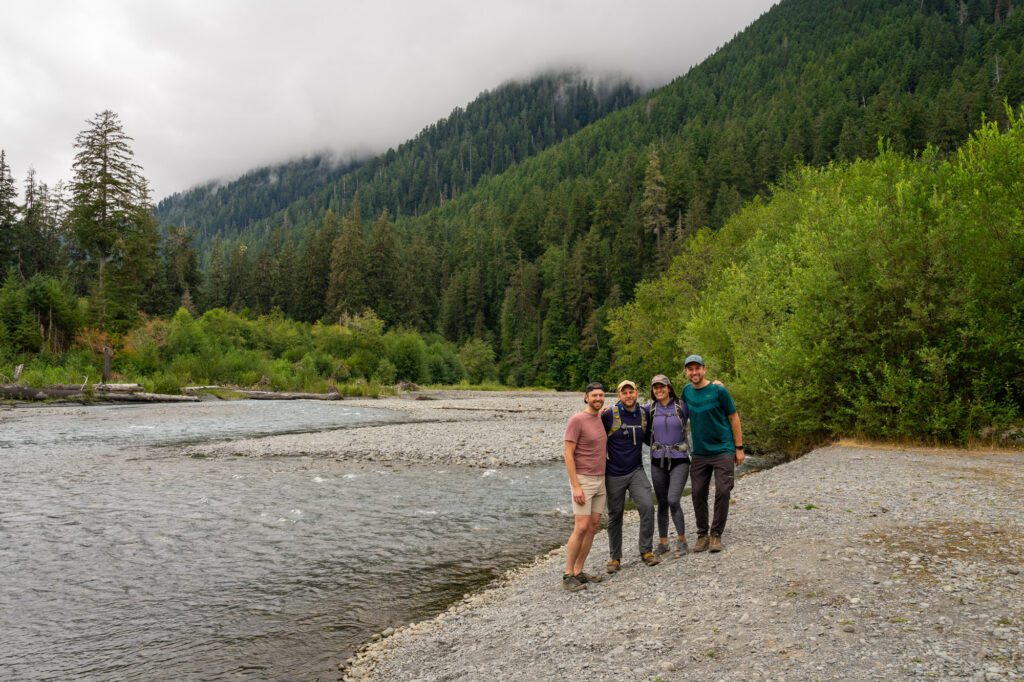
The issue we have with the Hoh Rainforest is that those two short hikes we mentioned earlier are absolutely jam packed with people, which is not really how the rainforest is meant to be experienced, we think.
The good news is that there’s a nice, relatively easy hike that will take you out further than about 99% of people are willing to go, following the path of the Hoh River.
The Hoh River Trail actually goes all the way out to Five Mile Island at the base of Mount Olympus, following the river the entire way. But for a shorter day hike option, hike out about two and a half miles to Mineral Creek Falls, where you’ll find a path that takes you out to the riverbank.
We did this hike with some friends last year, and the only other people we saw on the trail were backpackers heading into or out from the backcountry. It’s a huge contrast from the wild crowds you’ll find on the shorter trails nearby.
Spend a Night in the Enchanted Valley
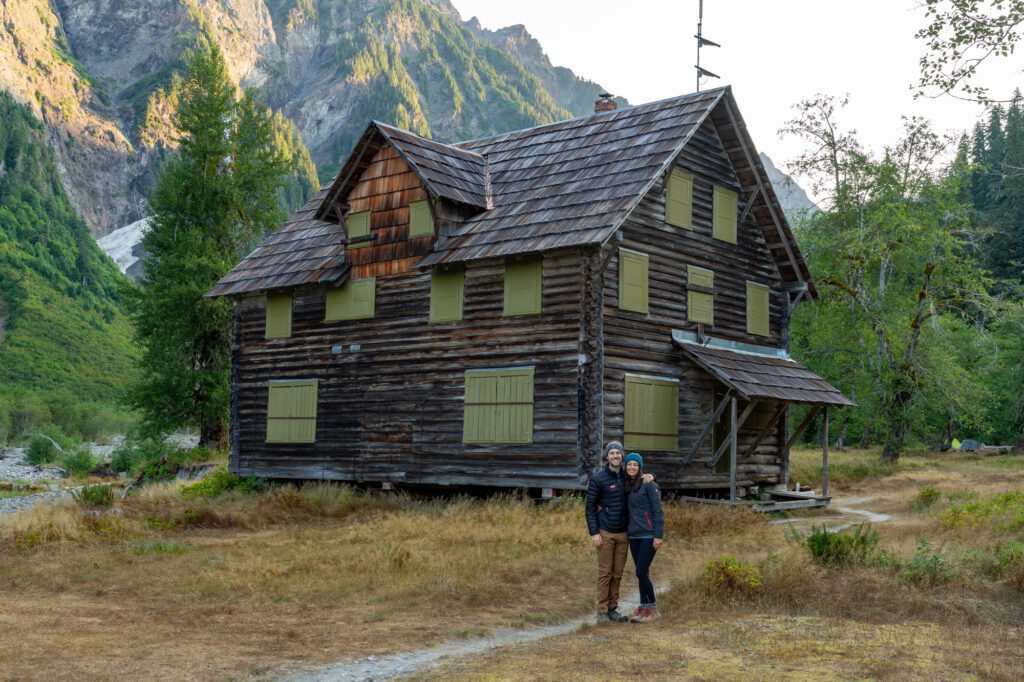
Another fantastic backpacking trail in Olympic National Park! The Enchanted Valley is a glacier-carved valley deep (ish) in the Olympic National Park backcountry.
The valley itself is gorgeous, and it’s worth spending a night or two soaking up the solitude out there. The hike is also great, following the East Fork of the Quinault River through the rainforest.
But the most famous part of the trail is the now-abandoned Enchanted Valley Chalet, which is a former park building that has since been closed, and now serves as a backdrop for pictures of people who make the journey out to the valley.
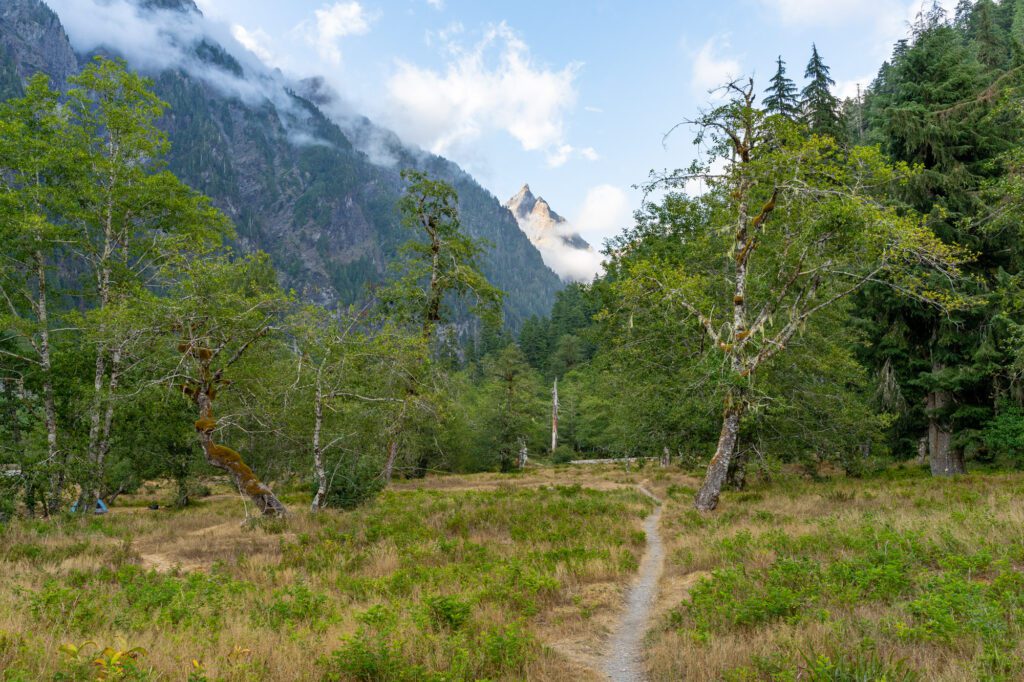
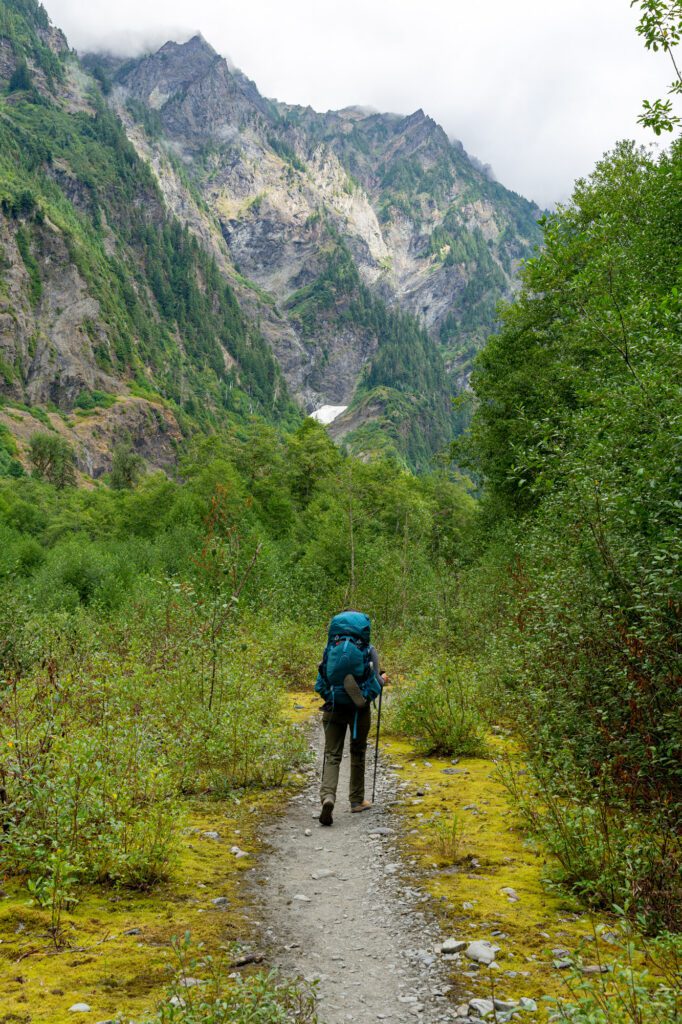
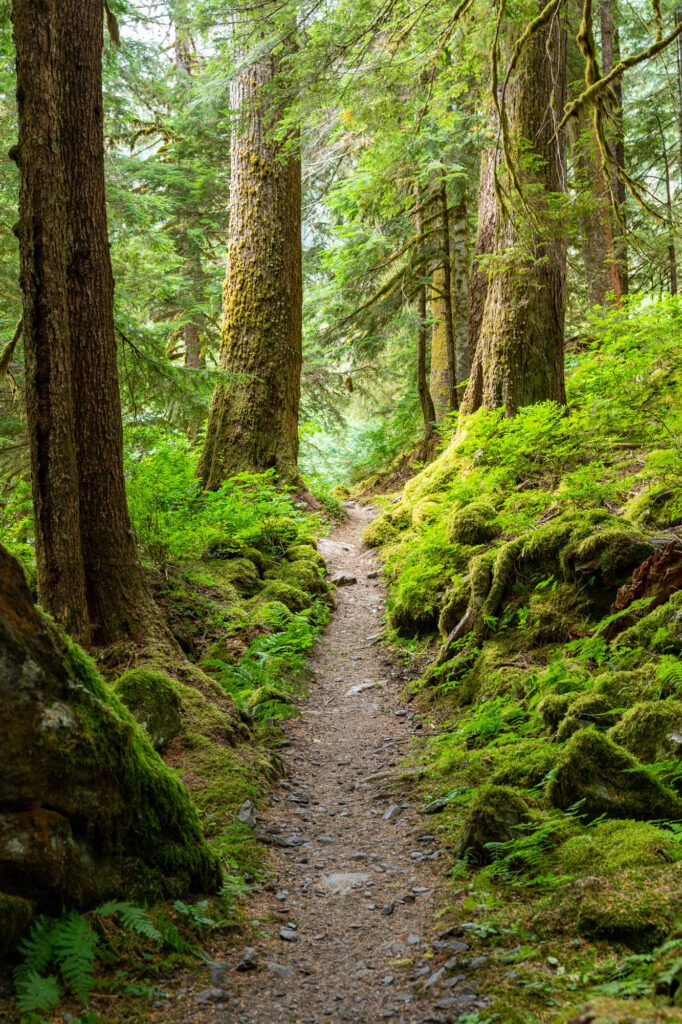
We did the Enchanted Valley trail the summer after the High Divide, and it’s hard to say which one we enjoyed more.
This one is slightly easier, at 27 miles roundtrip (in and out, no loop here) and only a gradual 3,200 feet of elevation gain along the way. You need a wilderness permit and a bear canister, just like any other backpacking trail in the park.
The Northern Pacific Coast
The northern Pacific Coast is up north of Forks, and is much less visited and more rugged than the stretch between Rialto and Kalaloch.
Which means it’s also a much more tranquil experience, with fewer fights over parking spots and crowded trails.
This part of the world is the home of the Makah Tribe, and to park at the trailheads for some of these beach hikes, you need to get a recreation permit from the tribe, which you can learn more about here.
It costs $20 for a year, you need to buy it in person, and you display it in your vehicle at the trailheads for Cape Flattery, Shi Shi Beach, and the Ozette Triangle (among others).
Make the Trek Out to Shi Shi Beach
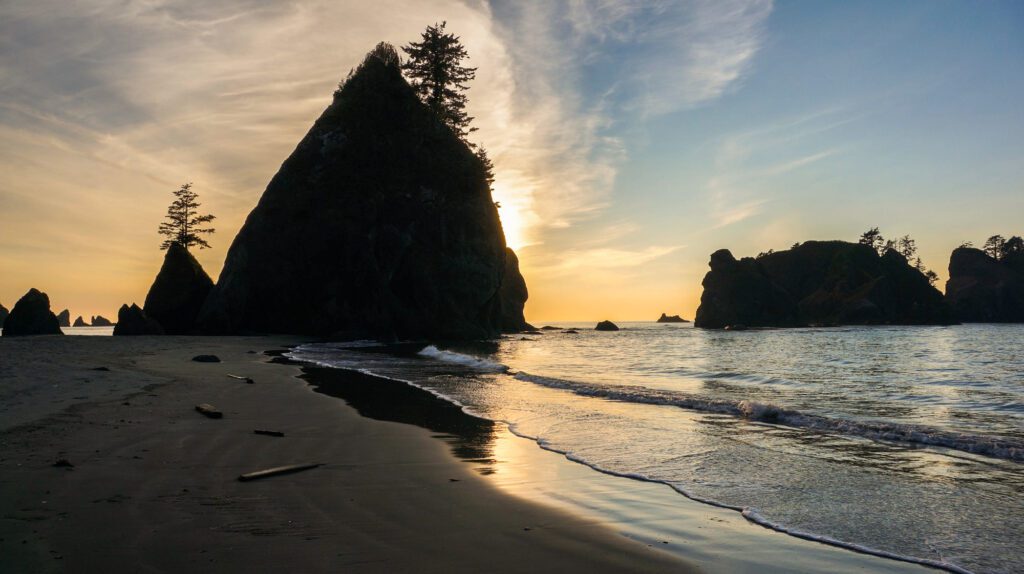
If you’re planning a trip out to Olympic National Park and you’re looking to hit the park’s best beaches, you really shouldn’t skip Shi Shi Beach.
It’ll take an hour and a half to get there from Forks or Lake Crescent, but we think the juice is really worth the squeeze here.
Plus, the fact that it’s that far out of the way means that there’s a fraction of the number of visitors as compared to places like Rialto, Ruby, and Kalaloch.
However, the other thing to know here is that it’s a two mile hike (one way) to get from the trailhead to the beach, with a little bit of up and down along the way.
Then, once you’re at the northern end of the beach, it’s another 2.5 miles to the southern tip of the beach and Point of Arches, which is the most beautiful part of the beach with towering sea stacks just offshore and tidepools at low tide.
It’s not a difficult hike in terms of elevation, but it is a long one. Still, it’s worth the long journey by car and on foot.
Bring a picnic lunch to eat perched on a piece of driftwood, listening to the sounds of the crashing surf of the Pacific and the squawking seagulls circling above you (likely plotting how to best steal your sandwich).
Also keep an eye out for bald eagles here!
Go Out to the Northwest Corner of the Contiguous United States
The northwest corner of the contiguous United States is an easy 1.5 mile hike (roundtrip) along a wooden boardwalk, and from the viewing platforms at the end you’ll have a fantastic view over the Pacific Ocean.
It’s a bit of a trek all the way out there (here’s the parking lot on Google Maps, which is about an hour and a half from Forks), and there are better coastal hikes to do in the park.
But if you want to make it to the edge of the country, you can do it here.
You’ll basically pass the trailhead here if you’re heading out to Shi Shi, so it’s a good add-on if you’re already planning on being out there.
Things to Know Before You Visit Olympic National Park
Before we get into our take on exactly what to do in Olympic National Park, let’s cover a few logistical items that will help make sure your trip is as smooth as it can be.
Here are some things to know before you visit Olympic National Park.
Entrance Fees for Olympic National Park
It costs $30 per vehicle to enter Olympic National Park (good for 7 days), and you can either pay online in advance (be aware that you must print it out and bring it with you), or at one of the park’s visitor centers.
There are visitor centers in Port Angeles, at Hurricane Ridge, and at the Hoh Rainforest.
If you are planning on visiting three or more national parks in the next 12 months, we’d highly recommend an America the Beautiful Pass, which covers entry to all national parks, national forest trailheads, national monuments, and more for 12 months.
It costs $80, which means it pays off with three national park visits (or some combination of national parks, forests, and monuments).
Olympic National Park is a BIG Park
Covering more than 1,400 square miles, Olympic National Park is gigantic. And the different parts of the park aren’t even all connected. It’s an odd layout, and the result is that it takes a long time to drive from one area of the park to another.
To illustrate that point, take two of the most popular parts of the park: Hurricane Ridge and the Hoh Rainforest.
It takes two and a half hours (105 miles) to drive between them. Granted, those are probably the two furthest points you could pick, but you get the idea.
Think about grouping different areas of the park together so that you can avoid driving hours and hours back and forth.
To minimize your driving, we’d group Hurricane Ridge and Lake Crescent and the Sol Duc Valley together, and the Pacific Coast and Hoh Rainforest together.
Gas Stations Around the Park
This one kind of goes along with the previous section. Because it’s a big park, you’ll want to keep an eye on your gas tank. There are gas stations in Port Angeles and Forks, but none in between.
It’s also worth noting that the gas in Forks is more expensive than Port Angeles, so fill up before you head out towards Forks if you can.
Crowds in Olympic National Park
If you’re visiting Olympic National Park in the summer (or a weekend in the spring or fall), you’re going to experience crowds.
There are a couple of things we’d say about crowds and how to avoid them as much as possible.
First, get an early start, and plan on staying out late. Peak time is from about 10:00 am to 4:00 pm, which makes the hours from 7:00 am to 10:00 am and 4:00 pm to 7:00 pm some of the best times to be out and about in the park. Plus, the rising/setting sun means the light will be better for pictures!
Second, know where the crowds are going to concentrate, and hit those areas early (or late).
The Hoh Rainforest and Hurricane Ridge are the big two that you’ll want to get to before 9:00 am (earlier if you can).
Rialto Beach is another popular spot with limited parking, and it’s a great sunset spot so we’d hit it in the late afternoon / early evening.
Download Offline Maps in Advance
There are parts of the park where you won’t have cell service, like at the Hoh Rainforest. We like to download offline Google Maps of places we’re visiting because it gives you the ability to navigate even if you don’t have service.
Here’s a guide on how to download offline maps.
Where to Stay for Your Trip to Olympic National Park
First of all, we have an entire guide dedicated to deciding where to stay in Olympic National Park. We’re going to give you a summary here, but if you want a more detailed look, you should definitely go read that guide.
Here’s the short version.
We think you should split your trip in half, and spend part of it staying on the northern end of the park in either Port Angeles (or around Lake Sutherland), and the other half around Forks.
That approach will make it so you don’t spend your entire time driving back and forth. Port Angeles / Lake Sutherland is a good home base for exploring Hurricane Ridge and Lake Crescent, and Forks is a great home base for the Pacific Coast and Hoh Rainforest.
What is the Best Time to Visit Olympic National Park?
Unlike the other two national parks in Washington State, Mount Rainier National Park and North Cascades National Park (which are in the heart of the Cascades and are basically closed six months a year), Olympic National Park is actually fairly accessible year round.
Summer is the best time to visit the park in terms of weather, but you’re making a deal with the devil in the summer because the crowds are, by far, the heaviest.
You’ll get nice, warm, long days, but you’ll want to be out as early as humanly possible to get parking at some of the popular trailheads and parking lots.
We like early fall – September and early October – as a nice balance of good weather and smaller crowds.
As you get deeper into October, the weather will get less predictable (read: a higher chance of rain), but you’ll also see a corresponding decrease in the number of visitors over that timeframe.
In the winter, the park goes into a bit of a hibernation, but the lower elevation regions of the park – the coast, Lake Crescent, and the rainforests – remain largely accessible.
Higher elevation areas like Hurricane Ridge and Sol Duc Road close intermittently, but the road to Hurricane Ridge is usually open on weekends even in the winter.
Check conditions before you go here.
There’s no getting around it – the weather in the winter is going to be dreary, with plenty of gray and rain.
The Hoh Rainforest gets an average of 60 inches of rain between November and January. Which is a TON of rain.
Obviously, that’s an extreme end of the spectrum, but expect to be wet if you visit in the winter.
The upsides of the winter are twofold. There are far fewer people in the park, and places to stay are relatively cheap.
Spring is another popular time to visit, with blooming wildflowers and roaring waterfalls. The park is coming out of its long, wet winter hibernation, and the wildlife is starting to stir.
Crowd levels are somewhere between fall and winter – there will be people around, but it won’t be absurdly busy like peak summer.
How Many Days Should You Spend in Olympic National Park?
By now, you’ve heard us say over and over again that the park is huge. Which begs the question, how many days should you dedicate to visiting Olympic National Park?
If you want to see the entire park, we’d recommend no fewer than three days.
Stay one night in Port Angeles and two nights in Forks, and make your way counterclockwise from the northeast corner of the park down to Kalaloch.
If you have less time than that, you’re going to have to save some things for next time.
With two days, we’d spend one day on Hurricane Ridge and Lake Crescent, and one day on the Hoh Rainforest (get there early!) and the Pacific Coast (focus on Rialto Beach and Hole-in-the-Wall, Ruby Beach, and Second Beach).
We have far more information on how to organize your time in our (very detailed) guide to planning your Olympic National Park itinerary, which has an itinerary that you can essentially copy and paste for your own trip.
Planning a Trip to Olympic National Park?
You won’t want to miss our detailed guides to visiting the Olympic Peninsula that are all based on our own personal experience exploring the park.

I am from the Midwestern and have traveled to WA four times but never had the chance to make it to Olympic National Park! I am finally visiting this year and am.so glad I came across this blog! This was so helpful and thorough! Thank you for posting this! I am even more excited after reading this and will be saving it to my favorites!
Thanks for the kind words, Sue! Olympic is amazing with its incredible diversity of landscapes, and you’re in for a treat when you visit. Cheers!